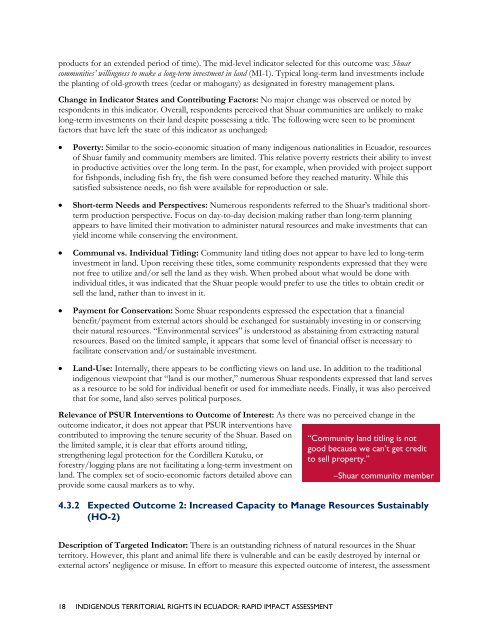ECUADOR - Land Tenure and Property Rights Portal
ECUADOR - Land Tenure and Property Rights Portal
ECUADOR - Land Tenure and Property Rights Portal
- No tags were found...
Create successful ePaper yourself
Turn your PDF publications into a flip-book with our unique Google optimized e-Paper software.
products for an extended period of time). The mid-level indicator selected for this outcome was: Shuarcommunities’ willingness to make a long-term investment in l<strong>and</strong> (MI-1). Typical long-term l<strong>and</strong> investments includethe planting of old-growth trees (cedar or mahogany) as designated in forestry management plans.Change in Indicator States <strong>and</strong> Contributing Factors: No major change was observed or noted byrespondents in this indicator. Overall, respondents perceived that Shuar communities are unlikely to makelong-term investments on their l<strong>and</strong> despite possessing a title. The following were seen to be prominentfactors that have left the state of this indicator as unchanged:• Poverty: Similar to the socio-economic situation of many indigenous nationalities in Ecuador, resourcesof Shuar family <strong>and</strong> community members are limited. This relative poverty restricts their ability to investin productive activities over the long term. In the past, for example, when provided with project supportfor fishponds, including fish fry, the fish were consumed before they reached maturity. While thissatisfied subsistence needs, no fish were available for reproduction or sale.• Short-term Needs <strong>and</strong> Perspectives: Numerous respondents referred to the Shuar’s traditional shorttermproduction perspective. Focus on day-to-day decision making rather than long-term planningappears to have limited their motivation to administer natural resources <strong>and</strong> make investments that canyield income while conserving the environment.• Communal vs. Individual Titling: Community l<strong>and</strong> titling does not appear to have led to long-terminvestment in l<strong>and</strong>. Upon receiving these titles, some community respondents expressed that they werenot free to utilize <strong>and</strong>/or sell the l<strong>and</strong> as they wish. When probed about what would be done withindividual titles, it was indicated that the Shuar people would prefer to use the titles to obtain credit orsell the l<strong>and</strong>, rather than to invest in it.• Payment for Conservation: Some Shuar respondents expressed the expectation that a financialbenefit/payment from external actors should be exchanged for sustainably investing in or conservingtheir natural resources. “Environmental services” is understood as abstaining from extracting naturalresources. Based on the limited sample, it appears that some level of financial offset is necessary tofacilitate conservation <strong>and</strong>/or sustainable investment.• <strong>L<strong>and</strong></strong>-Use: Internally, there appears to be conflicting views on l<strong>and</strong> use. In addition to the traditionalindigenous viewpoint that “l<strong>and</strong> is our mother,” numerous Shuar respondents expressed that l<strong>and</strong> servesas a resource to be sold for individual benefit or used for immediate needs. Finally, it was also perceivedthat for some, l<strong>and</strong> also serves political purposes.Relevance of PSUR Interventions to Outcome of Interest: As there was no perceived change in theoutcome indicator, it does not appear that PSUR interventions havecontributed to improving the tenure security of the Shuar. Based onthe limited sample, it is clear that efforts around titling,strengthening legal protection for the Cordillera Kutuku, orforestry/logging plans are not facilitating a long-term investment onl<strong>and</strong>. The complex set of socio-economic factors detailed above canprovide some causal markers as to why.“Community l<strong>and</strong> titling is notgood because we can’t get creditto sell property.”–Shuar community member4.3.2 Expected Outcome 2: Increased Capacity to Manage Resources Sustainably(HO-2)Description of Targeted Indicator: There is an outst<strong>and</strong>ing richness of natural resources in the Shuarterritory. However, this plant <strong>and</strong> animal life there is vulnerable <strong>and</strong> can be easily destroyed by internal orexternal actors’ negligence or misuse. In effort to measure this expected outcome of interest, the assessment18 INDIGENOUS TERRITORIAL RIGHTS IN <strong>ECUADOR</strong>: RAPID IMPACT ASSESSMENT
















